I have previously mentioned that the Washington International was the best run and most enjoyable tournament I have ever played in. One reason was the fact that all equipment, sets and clocks, was provided. And not just any equipment! Look at these beautiful wooden chess sets we were given to play with:
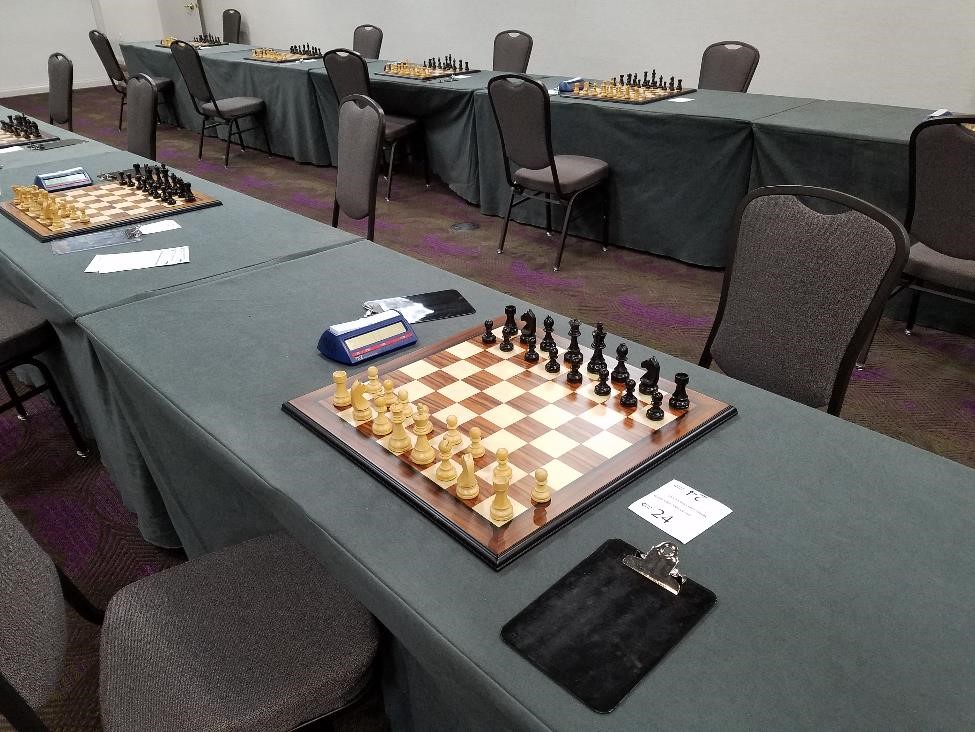
They even gave us little clipboards for our scoresheets, since the table cloths were a little soft.
And just look at how spacious the playing rooms were:
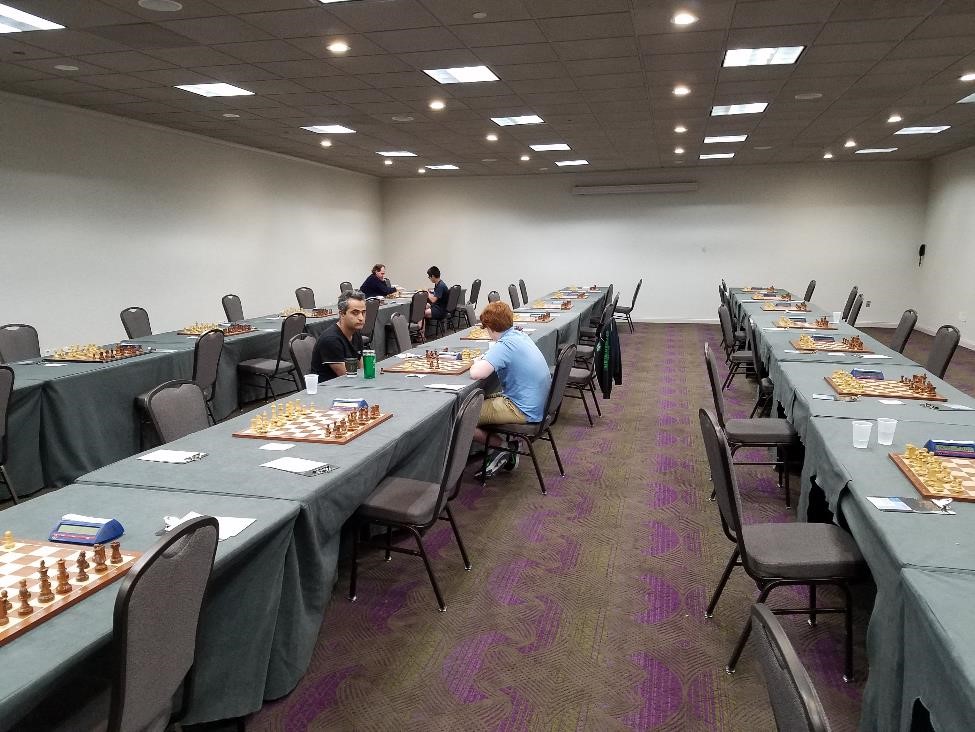
So much space between boards and between tables! Those of us accustomed to the Amateur Team East, where hundreds of players are packed into a tiny space, and God help you if you flick your elbow out too fast, can be brought to tears by such playing conditions.
Let me reiterate. After receiving your pairing by text message, you simply walked to the appropriate board, and sat down to a beautiful wooden chess set, a ready-to-go digital clock, and a blank scoresheet on a clipboard. Wonderful stuff!
Incidentally, the second photo was taken near the end of the fourth round. The fellow giving me stink eye was glumly defending king, rook, and pawn against king, rook, and two pawns. About five minutes before this photo was taken, there were three games going on. That was mine! Let's see what happened.
Having lost in the previous round, I got a more reasonable pairing in Round Five. My opponent was rated 1868. I had my second black in a row (but remember that I had two whites on the first day.) The opening was...another Giuoco Piano! My second of the day. This time, though, my opponent played a very unassuming line that quickly led to a bunch of trades. Here's an interesting position, with black about to play his tenth move.
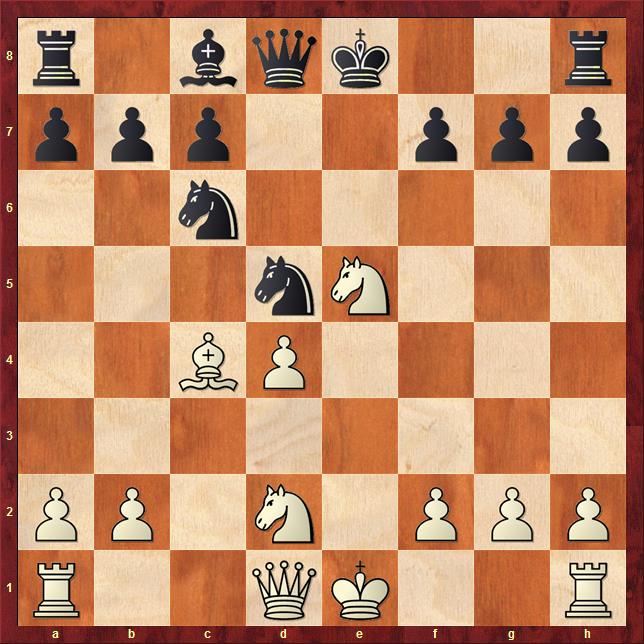
I took the knight on e5. That's not what's interesting. The interesting part is that the computer agrees that taking the knight is the best move, but also suggests that castling is a very close second. That's a move I would never have considered. White would just take the knight on c6, and after black retakes with his pawn his queenside pawn structure is shattered. For me, that would have been the end of it. But apparently the computer reckons that black's lead in development and active pieces compensate for the weak pawns.
Incidentally, it's a very bad idea for black to take the pawn on d4. White replies Ne4, and after c5 by black to protect the knight white continues with Nxf7, launching a classic sort of attack.
In preparing for the tournament I started going through Lars Bo Hansen's book How Chess Games Are Won and Lost. One observation he makes is that modern grandmasters are far more willing to accept doubled pawns, in return for active pieces, than they used to be. I gotta tell you though, those would have to be very active pieces for me to accept those pawns. Apparently it's a decent way to play, though.
Anyway, here's the position with black about to play his twenty-first move.
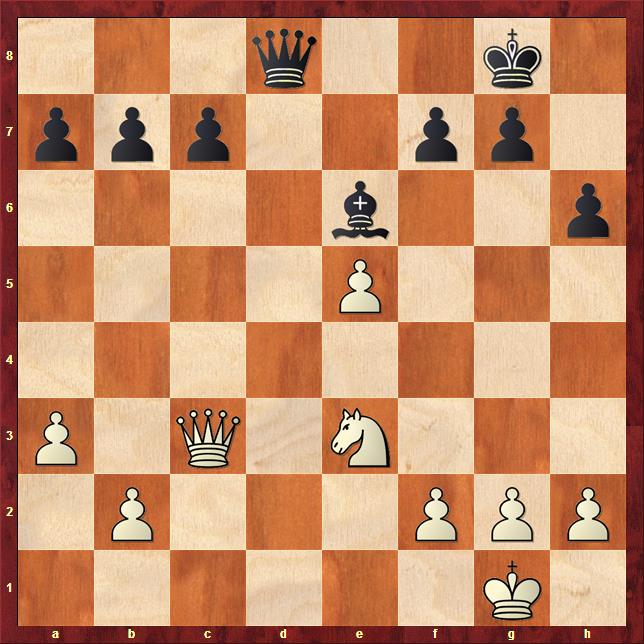
White had just moved his queen from c2 to c3 and offered a draw. That got me thinking.
On the one hand, the position really is very level. Had my opponent been higher rated than me, I would surely have accepted the draw and would then have moved on to the problem of deciding where to go for dinner.
But with the difference in our ratings, a draw would have cost me five rating points. Let us recall that my sole reason for playing in this event was to gain the four points I needed to get my rating over 2000. Moreover, it seemed to me that black had a few things going for him. He has the better pawn majority, a bishop against a knight, and a potentially weak pawn on e5 to aim at. If white starts advancing his kingside pawns, then he is vulnerable to queen invasions by black.
And then there was the fact that my opponent's very quiet play and quick draw offer suggested that he had been playing for a draw all along. So make him work for it!
I played 21. ... c6, and the game continued. In our next diagram, white has just made his twenty-eighth move.
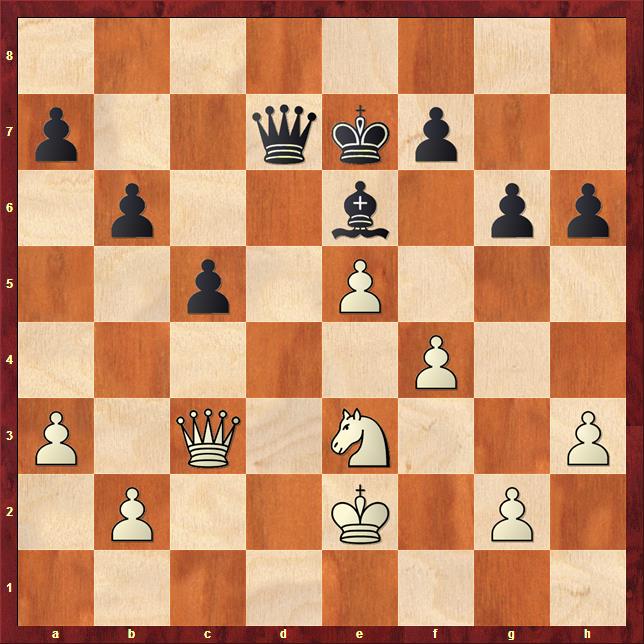
He offered another draw. That really bugged me. It's very rude to keep offering draws like that. Usually the rule is that you're only allowed to offer one draw per time control.
I declined the draw offer and moved my queen to c6. It would be pointless to try to offer a detailed analysis of everything that might have happened. Suffice it to say that objectively I haven't made a whole lot of progress, but his desperation for a draw had me feeling confident.
Things didn't really start to get interesting until black was about to make his thirty-second move.
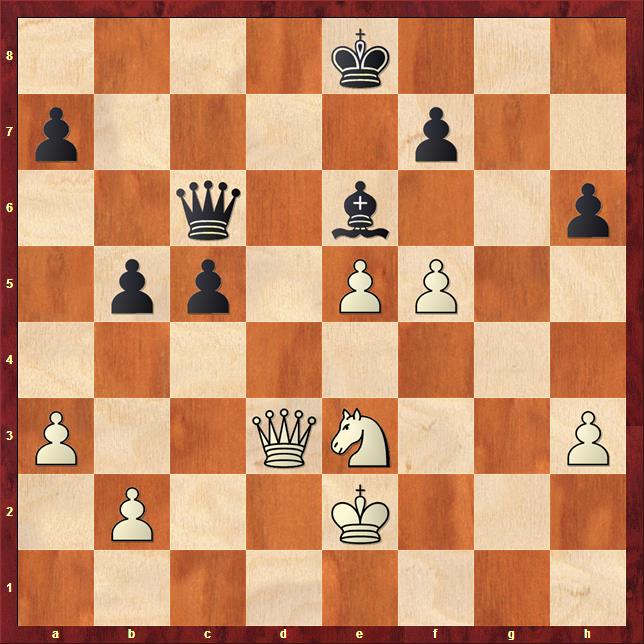
I was feeling good, since all of those pawn moves on the kingside got me thinking about an eventual queen invasion. But I have an immediate problem on my hands. My bishop is attacked. What to do?
I spent a lot of time pondering Bc4, with the queen going to g2 after white takes my bishop with his knight. But white's queen gets just as active as black's, so I decided against it.
Then Bc8 comes to mind. This is a very promising move, since it will then transfer to b7, where it will support the long-anticipated queen invasion. But there seems to be a problem. After 32. ... Bc8, white can reply with 33. Nd5, followed by planting the knight on f6. Around here I started to worry that provoking white into advancing his kingside pawns might not have been the best idea.
So you can imagine my joy in discovering a tactical refutation of 33. Nd5. Black plays 33. ... Bxf5. If white takes the bishop with his queen, then black returns the favor by taking the now hanging knight on d5. But not so fast! What if white replies 34. Nf6+? It looks like white has saved his knight, and will take the bishop for free next move while black is wasting time getting out of the check. But black now has 34. ... Qxf6! Black is reminding white that there are two queens on the board, and one of them is his!
But we're not done. What if white now plays 35. Qxb5+? Why, then we have 35. ... Bd7. And if white now plays 36. Qb8+? Then 36. ... Qd8 of course. End of line. Black has won a piece.
After checking that line many, many times, I played 32. ... Bc8. White did not reply with Nd5.
A few moves later I got my precious queen invasion.

I played 35. ... Qh1, though the computer churlishly suggests that Qf3 was better.
Now, I should mention that my opponent was in very serious time pressure throughout this phase of the game. Somewhere around here he allowed his clock to go all the way down to one second before banging out a move (and thereby earning thirty seconds added to his clock). So I give my opponent a lot of credit for avoiding some of the more crass tactics he might have fallen into.
Play continued 36. Qd6 Be4+ 37. Kd2 Qh2+ 38. Kc3 Qxh4 39. Qxc5 Qd8 40. Qd4, leading to this position:

My opponent was doubtless relieved to make it to move forty, meaning that twenty minutes were added to his clock. But his last move allows a little tactic. I played 40. ... Qc8+, which wins the f-pawn after 41. Kb4 Bxf5.
Finally! Something tangible for all my hard work.
The thing is, though, that white is still OK. It's not good to lose a pawn, of course, but white can now play the Nd5-f6 maneuver we saw earlier. White's knight and queen will become so active it is very hard for black to make progress. After all, there are two kings on the board and one of them is his! Only a small advantage to black, according to the computer.
But now, similar to what happened in the first round, my opponent seemed to get a bit deflated. He immediately traded the minor pieces on f5, leading to a pure queen endgame. I was happy about this. A few moves later, this was the position.

Black has found shelter from the checks and has positioned his queen on a square where it covers all of his pawns. Yay! But while I was waiting for my opponent to move, I started wondering how I would make progress after 49. Ka5. It looks like as soon as black's queen gets active, white just eats the queenside pawns and suddenly he has real counterplay. The computer gives black a clear advantage, but far from a decisive one.
My opponent played 49. Kc5 instead. After this, white is just lost. I think his idea was to bring the king to the kingside to help in the effort against black's h pawn. The trouble is that that pawn is very fast. Pretty soon we had this position, with black to play his fifty-eighth move.

OK. Here's your endgame exercise. Does 58. ... h2 win for black? It gives up the f pawn with check, so you'd better be sure.
After using much of my remaining time trying to figure out if black could escape the checks, and also wondering about whether white's now-passed e pawn was dangerous, I played it. And I was right, as the computer confirms! The key is for black to march his king right into the heart of white's position. The main idea in these sorts of queen endings is that black wants to answer a check with a check. To do that, he generally wants his king to be on the same rank as, or one rank removed from, the opposing king.
Play continued 59. Qxf7+ Kh4 60. Qh7+ Kg3 61. Qg6+ Kf2 62. Qc2+ Kf3 63. Qf5+ Ke3 64. Qd3+ Kf4, leading to this position.

Black wins! White has no more useful checks. If 65. Qd4+ then 65. ... Qe4. We then have 66. Qd2+ Qe3+ or 66. Qf1+ Qf3+. Either way, black answers a check with a check!
White could now resign, but he played it out with 65. e6 h1Q 66. Qd6+ Kf5 67. e7:
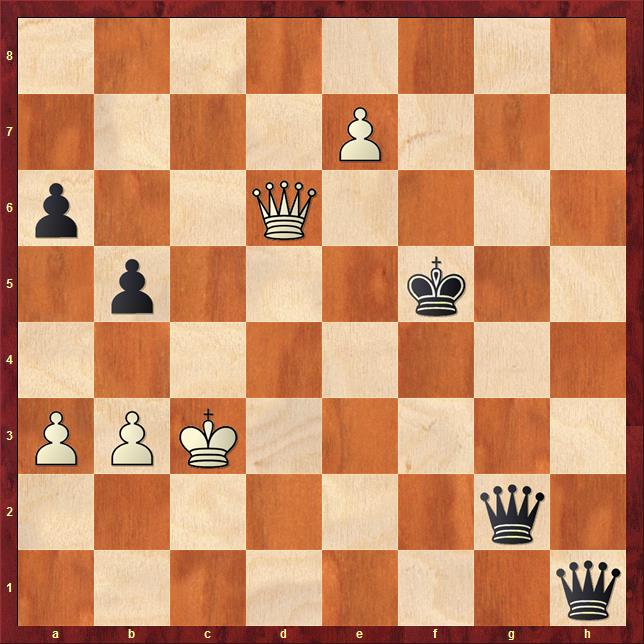
Now the computer helpfully points out that 67. ... Qe1+ 68. Kd4 Qgf2+ 69. Kd5 Qh1 is mate. Clever! Instead I instantly played 67. ... Qc6+. After the reply 68. Kb4, taking the white queen on d6 with check would certainly get the job done, but I managed to find 68. ... Qe1+ 69. Qd2 Qxd2 mate.
Game over!
It's funny how absorbed you can get in a game of chess. I was concentrating so intently on my game that I was shocked, after playing my final move, to discover that the room was practically empty. Everyone else's games had finished more expeditiously.
That little adventure netted me eleven rating points. Together with the one point I had from the previous games, I was at plus twelve!
Compared to that, the next two games were anti-climactic. But we shall take a quick look in the conclusion to this series...

Another episode of "Chess As Struggle".
Queen + pawn endings with Kings out in the open ALWAYS scramble my brains. I would doubtless have lost on time in your position trying to analyze all the checking after 58...h2.
It does surprise me that he didn't play the Nd5-f6 maneuver as you suggested. It would've given him some threats.
A very strong, persistent game on your part. Must've felt good to finish that one off.
37.Kb3 is better - Black can't snatch the h-pawn.
Computers are notoriously unreliable in queen endgames. Rybka thinks white is dead lost after 49.Ka5 h4. Instead 49.Qf2 might be the best try as after Qe4+ 50.Ka5 Qxe5 51.Qg1+ Kh6 52.Kxa6 any win is not going to be easy.
Good job calculating 58...h2. I'm far from sure I could have done it, especially that late in the game.
Thanks for the kind words. I have a small book called Botvinnik on the Endgame, one chapter of which discusses a queen ending similar to this one (but with fewer pawns). Botvinnik had the extra pawn in that case. Botvinnik discusses the technique of placing your king one rank removed from your opponent's king, to make it easier to answer a check with a check. His grandmaster opponent did not know this technique, and blew a draw because he misplaced his king at a crucial moment, allowing Botvinnik to implement his plan.
Sometimes book learnin' comes in handy!
MNb--
I was using Houdini as my analysis engine. I should mentioned that I was usually only giving the computer five to ten seconds to analyze, so it's possible it would have changed its assessment if I gave it more time.
The NJ Open is this weekend. Just sayin'.
I think I've had enough chess for a while. I'm retired until February!